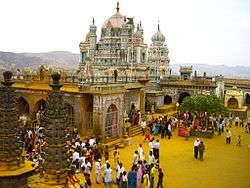Kalaram Temple
The Kalaram Temple is an old Hindu shrine dedicated to Rama in the Panchavati area of Nashik city in Maharashtra, India. It is probably the most important Hindu shrine in the city.
The temple derives its name from the statue of Lord Rama that is black. The literal translation of kalaram means black Rama. The sanctum sanctorum also houses the statues of goddess Sita and god Lakshmana. Thousands of devotees visit it every day.
The temple was funded by Sardar Rangarao Odhekar, and was built around 1788. It was said that Odhekar had a dream that the statue of Rama in black colour was in the Godavari River. Odhekar took the statue from river and built the temple.[1]
The temple formed a pivotal role in the Dalit movement in India. B. R. Ambedkar led a protest outside the temple on 2 March 1930, in order to allowing Dalits into the temple.[2][3]
The main entrance has a Lord Hanuman deity which is black. There is also a very old tree that has Lord Dattatreya's footprint impressions marked on a stone. Pilgrims visit the Kapaleshwar Mahadev temple near the Kalaram Temple.
| Wikimedia Commons has media related to Kalaram Temple. |
References
- ↑ J. Gordon Melton (15 January 2014). Faiths Across Time: 5,000 Years of Religious History [4 Volumes]: 5,000 Years of Religious History. ABC-CLIO. pp. 1355–. ISBN 978-1-61069-026-3.
- ↑ Rāmacandra Kshīrasāgara (1 January 1994). Dalit Movement in India and Its Leaders, 1857-1956. M.D. Publications Pvt. Ltd. pp. 123–. ISBN 978-81-85880-43-3.
- ↑ K.N Jadhav (1 January 2005). Dr. Ambedkar and the Significance of His Movement. Popular Prakashan. pp. 93–. ISBN 978-81-7154-329-8.


